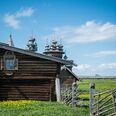Uglich - a Popular Stop on Moscow to St. Petersburg River Cruise
- access_time7 April, 2015
Uglich is a small town in the Yaroslavl region. It is located on the banks of the Volga River, in the place where it makes a sharp bend which was called "Ugilets" or "Uglich". Probably this is what gave the city its name. According to another version, coal was burned in the area in the old days, and the city’s name derives from Russian word “ugol” which means “coal”. Uglich is also a part of Golden Ring – a group of ancient towns located to the northeast of Moscow and famous for their rich history and amazing architecture.
Uglich was first mentioned in chronicles in 937r. In the 13th century the city became the capital of a small principality, which later became a part of Moscow principality. There was a tragic page in the city’s history: the son of Ivan the Terrible, Tsarevich Dmitry, was exiled here and died suddenly. His death remains one of the biggest mysteries in Russia’s history. This event preceded the “Timed of Trouble" - a bloody époque of civil wars, impostors and intervention. Gradually the 19th century Uglich became a provincial town.
Among the oldest survived buildings in Uglich ancient churches are most impressive. The main attraction of the town is the Kremlin standing on the steep bank of the Volga River. It was built during the reign of Andrey Bolshoy (brother of Ivan III) in 1480-1490 years. The oldest part of the Kremlin is the Chamber of Tsarevich Dmitri.
Church of St. Dmitry on the Blood was built in 1692 on the site where Tsarevich Dmitry died. The church is painted red, which symbolizes shed blood, whereas the white ornament and blue dome with gold stars give hope for resurrection and ultimate forgiveness.
Nearby Transfiguration Cathedral is located. It is decorated with magnificent paintings of the Gospels, as well as an impressive six-row iconostasis. In the summer, men’s choir sings Orthodox chants here. The nearby bell tower built in 1730 became symbol of Uglich.
Other important attractions in Uglich are the Monastery of St. Alexis (founded in 1371 and currently an active Orthodox Convent), Resurrection and Epiphany Monasteries (founded in the 14th century), and Nikolo-Uleyminsky Old Believer Monastery (founded in early 15h century).
Apart from churches, there is also a plenty of museums in the city, such as The Museum of Russian Antiquities located in the Kremlin, Museum of Urban Life, Museum of Hydropower, Museum of "Chaika" Clock Factory, Puppet Museum, Museum of Myths and Superstitions of the Russian People, Museum of the History of Russian Vodka, Museum of Prison Art and more.




